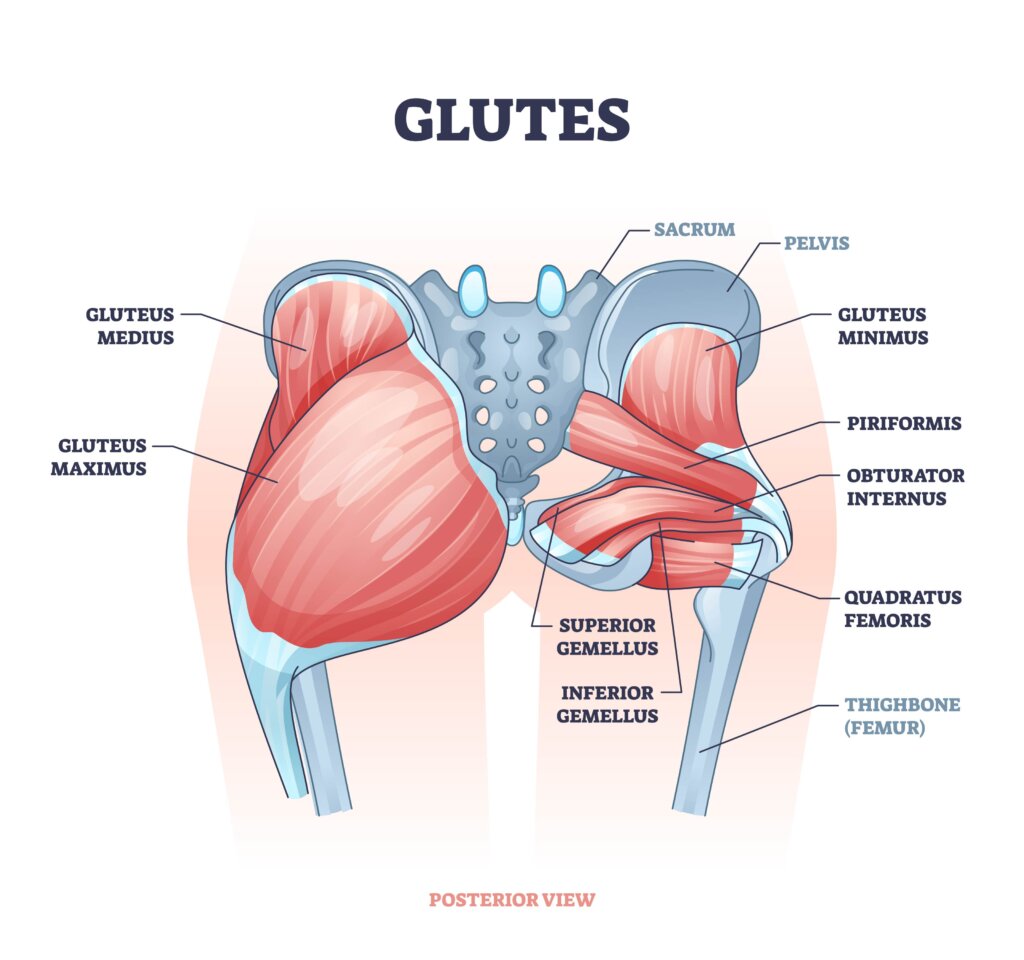(Gluteal Tendinopathy)
Lateral Hip pain is a painful condition affecting the outer thigh and hip area. It occurs when the tissues that lie over the bony prominence (the greater trochanter) at the top of the thigh bone become irritated. These can include tendons, muscles or bursae (fluid-filled sacs that help smooth movement between muscles, tendons and the hip bone). This irritation may have occurred for a number of reasons, but it is most often due to overload – the structures are unable to cope with the strain applied to them.

What are the symptoms of Lateral Hip Pain?
Pain in your outer thigh and hip area. This may feel like an aching or burning pain.
- The pain may be more intense when you are lying on your side, especially at night.
- It may become worse with exercise and you may find you walk with a limp.
- It can be worse after sitting in a chair/car or when getting out of bed for the first few steps.
It is diagnosed in clinic through taking a history and doing specific tests of the hip. Usually, scans are not required to diagnose this problem.
What causes Lateral Hip Pain?
It is most common in middle aged females. The exact causes is not fully understood, but there are many factors that can contribute to it, including:
- direct fall on outside edge of hip
- excessive load, for example prolonged walking or running. Poor running style can also lead to increased load on this area of the hip.
- prolonged or excessive pressure to your hip area (for example, sitting in bucket car seats, or sleeping on your affected side, may aggravate the problem)
- weakness of the muscles surrounding the hip, called the gluteus medius and minimus
How is Lateral Hip Pain Managed?
To improve symptoms in the short term, you can try the following:
- Decrease aggravating activities, such as running or excessive walking.
- When you are standing still, avoid leaning all your weight on one hip and keep your weight evenly through both feet.
- Avoid sleeping on the aggravated side. If sleeping on the opposite hip, try placing a pillow between your knees to stop your painful leg crossing over.
- Avoid sitting with your legs crossed.
- Losing weight.
- Pain killers may be used to provide short term pain relief.
As Lateral Hip Pain is most often related to hip structures not coping with heavy/frequent load, exercises to strengthen this area will help healing and returning to normal activity. Below are exercises to do in the early and later stages of your rehabilitation. Your physiotherapist may identify other specific exercises for you to complete. You should follow the instructions and monitor your performance of these carefully. Load is needed to aid recovery but overload may worsen your pain.
Exercises for early stages
- Stand, holding on to a stable surface, such as a chair or table, for balance. Lift your painful leg out to the side and then slowly lower back to normal standing position. Aim to complete three sets of 10-12 repetitions.
- Stand with your painful leg away from the wall. Lift your unaffected leg up to 90 degrees. Push against the wall with your knee. You should feel the muscles on the outside of the painful hip working. Hold this position for 20-30 seconds. Repeat three times.
- With a resistance band around your ankles, stand in a mini squat position. Take 10 slow and controlled steps to the left and then repeat to the right. Ensure you stay in a squat position. Repeat three times.
Exercises for later stages
- Hip Abduction Lie on your unaffected side with a pillow between your knees. Make sure your top leg is in line with your body. Lift the leg up towards the ceiling and slowly lower back to the starting position. Complete three sets of 10-12 repetitions.
- Side Plank on Knees Lie with your painful leg towards the floor, with your knees bent behind Push up on your elbow, lifting your hips up so they are in line with your body. Hold for 20-30 seconds. Repeat three times.
- Side Plank on Feet will make the plank exercise more challenging. Do the above with your knees straight.
- Step ups Without using the handrail, step up and then slowly down from the bottom step of the stairs with your painful leg. Complete three sets of 10-12 repetitions.
How long does it take to get better?
Everybody will improve at different rates, but for most people it will take some months of focused rehabilitation to make a return to full normal activities without pain. It is normal to have periods of increased pain or flare ups during this time. If this happens, you may need to reduce your exercises until the pain subsides. If symptoms don’t improve within six to nine months, even when you have been completing an appropriate exercise programme, other treatment options, such as an injection or Extracorpeal Shock Wave Therapy, may be considered. Injections can be helpful if the bursa is inflamed and Extracorpeal shock wave therapy if the tendon (tendinopathy) is the cause of the pain. These are not suitable for all patients and so should be discussed with a medical professional.
Extracorpeal Shock Wave Therapy
Can be a successful treatment for the relief of persistent pain of the Gluteal tendon. The patient must have stopped aggravating the pain and have tried the strengthening exercises above. On average 3-6 weekly sessions may be required.
